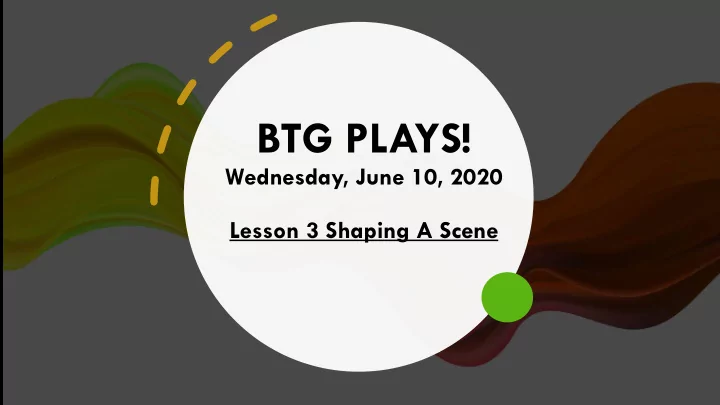

BTG PLAYS! Wednesday, June 10, 2020 Lesson 3 Shaping A Scene
Objective: A goal; something important one wants to achieve. Obstacle: A person or thing that stands in the way of BTG PLAYS! achieving and objective. Lesson #2 Conflict: Disagreement; argument; battle; a struggle between two opposing objectives which creates the drama in a play or story. Vocabulary Tactics: Different methods a character might use to Words overcome an obstacle in order to achieve an objective. REVIEW Character: An individual in a play, movie or novel.
Here is an example of a conflict chart. Notice that each character wants something (objective) that causes a problem for the other character, and each character has a specific reason (why?) for their goal. But because their objective will put them in conflict with each other, they need to use tactics to get what they want. Character #1 : A Shopping Cart BTG PLAYS! Objective: To race around the store on The Floor. Why: To get all of the good sale items Conflict Tactics: 1. Boasting 2. Flattering 3. Bargaining Chart __________________________________________________________ Character #2: The Floor Example Objective: To stop the Shopping Cart from racing around on him. Why: To stay shiny for the customers REVIEW Tactics: 1.Explaining 2. Ordering 3. Threatening/Lying
BTG PLAYS! Lesson 2 Writing Exercise #3 Conflict Chart - REVIEW Now it’s your turn to fill in a Conflict Dialogue Chart. Use your imagination to come up with two characters in a grocery store (anything but people!) and give them objectives and reasons that cause a problem for the other characters and create a conflict. Then, choose three tactics for each character that will help them get what they want. Character: #1 ________________________________________________________________________ Objective: __________________________________________________________________________ _____________________________________________________________________________________ Why :________________________________________________________________________________ Tactics: 1.____________________ 2._________________________ 3.____________________ Character: #2 _________________________________________________________________________ Objective: ____________________________________________________________________________ _______________________________________________________________________________________ Why :__________________________________________________________________________________ Tactics: 1.____________________ 2._________________________ 3.____________________
Scene: A section of a play that is defined by: a change in location or a change in time. Setting: The specific time and place of a scene. BTG PLAYS! Stage Directions: Descriptions of the actors’ Lesson #3 physical actions in a scene, written in parentheses. Vocabulary Dialogue: A conversation between two or more characters written to be spoken in a play. Monologue: Words spoken by a single character as if he or she were thinking aloud.
Protagonist: The “hero;” the main character in a play or story. The protagonist resolves the main conflict and learns the most throughout the story. BTG PLAYS! Antagonist: The “villain;” a character who Lesson #3 opposes the protagonist because it is her journey that we follow from the beginning Vocabulary to end. Supporting Characters: Characters in a play or story who help either the protagonist or the antagonist.
Title: Trouble in Aisle 5 Conflict Setting: A grocery store, in the middle of the day (The Shopping Cart is racing madly around the store.) Dialogue Floor: Hey , Shopping Cart! I just polished myself so that I’ll be nice and shiny for the customers! You’re leaving scuff -marks on me! Shopping Cart: Sorry, Floor. I’m trying to get all the sales for the customers! Scene That’s more important than a shiny floor. Floor: Look , if I weren’t here, you would have nothing to race around on. So, SLOW DOWN and stop marking me up! Example Shopping Cart: You’re so beautiful! And the scuff marks really accent your checkerboard tile. Floor: (flattered) You think so? (Shopping Cart peals out and leaves Here is an example of a another scuff mark) OW! Wait a minute! Not only doe these scuff Conflict Dialogue Scene using marks make me look bad, they hurt! If you don’t stop…I’ll…I’ll…I’ll turn myself into ice and you’ll go skidding off into innocent people. the two characters from our You’ll hurt the customers and bruise the…fruits and example chart. We find out ( in vegetables …probably . dialogue ) what both characters Shopping Cart: (pause) Yeah, right. (thinks for a second) I’ll tell you what …the mop owes me one. If you let me skid around want, their reasons for their during the day, the mop will clean you up nice and shiny at objectives, and the different night. Deal? tactics that they use to Floor: Ummm ….okay! I like shiny! overcome their obstacles. Shopping Cart: I know.
Lesson #3 Writing Exercise #4 Conflict Dialogue Scene Now, it’s your turn to write a Conflict Dialogue Scene using the characters, objectives and tactics from your chart. Here are the rules… 1) Skip lines between each character’s section of dialogue (so it’s easier to read.) 2) Add stage directions (in parentheses) when you want to show what a character is doing, not what the character is thinking. 3) Make sure that at some point in the dialogue, each character states their objective and the reason why they want to achieve it. 4) To make the conflict stronger, make sure at least one of your characters wants something from the other character. 5) In your scene, each character should use three separate tactivs. (This means you will have a least six lines of dialogue.
Lesson #3 Writing Exercise #4 Conflict Dialogue Scene Remember to title your scene and give the setting… Before you begin… Here are some questions the audience may be asking themselves when they go to see a play… Who? (Characters names) Where and When? (Setting) What do they want? (Objective) Why? (Reason for Objective How? (Tactics) Now think carefully!!! If the audience is going to be asking these questions when they go to see a play, you should be answering the questions for yourself when you write.
Recommend
More recommend